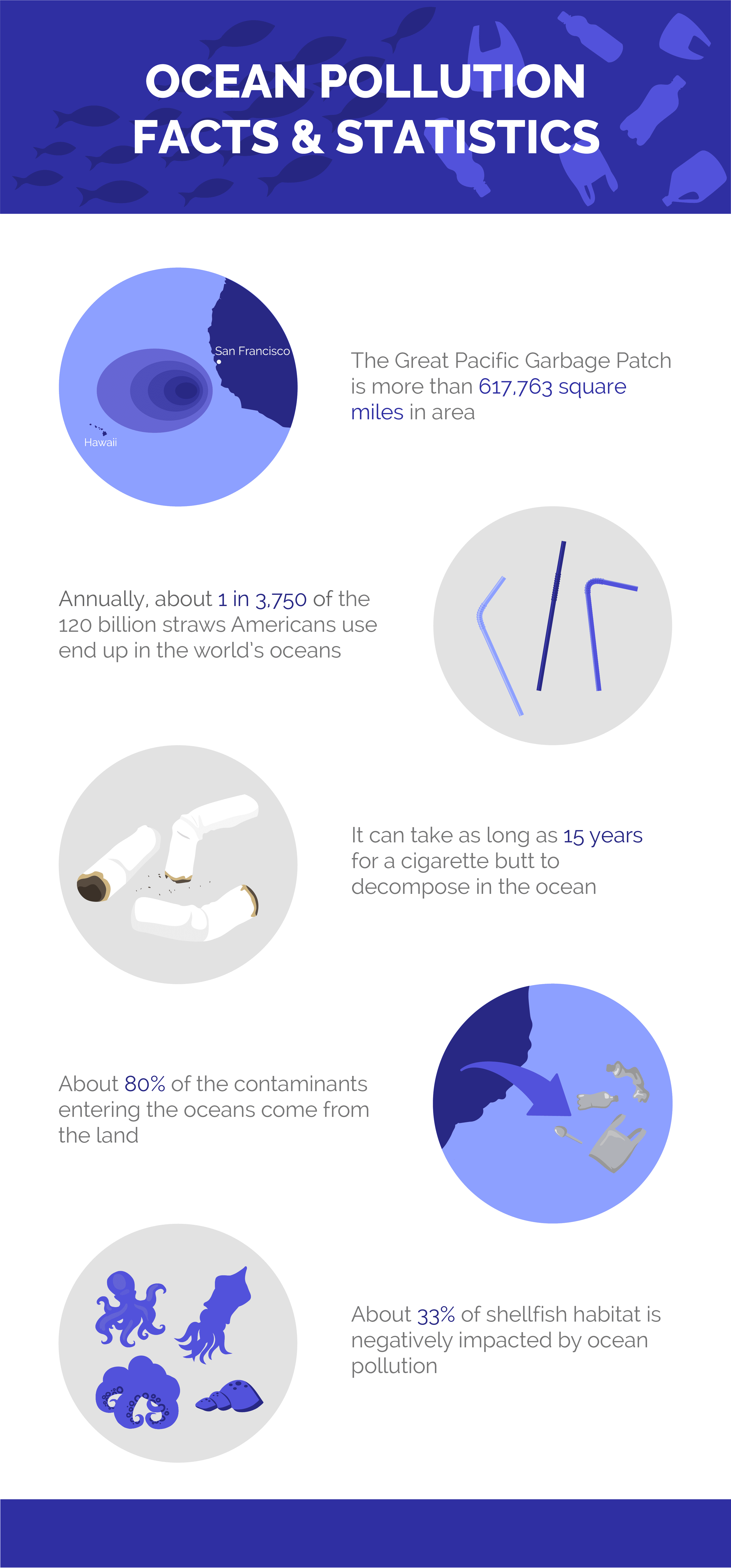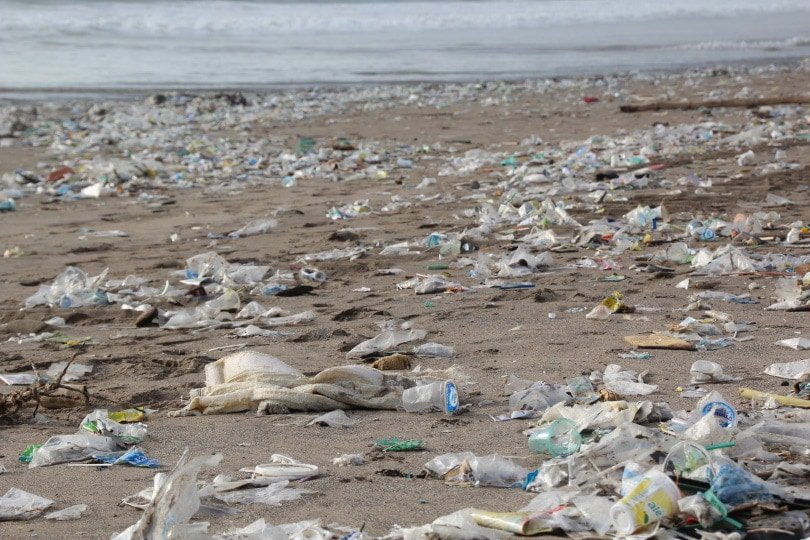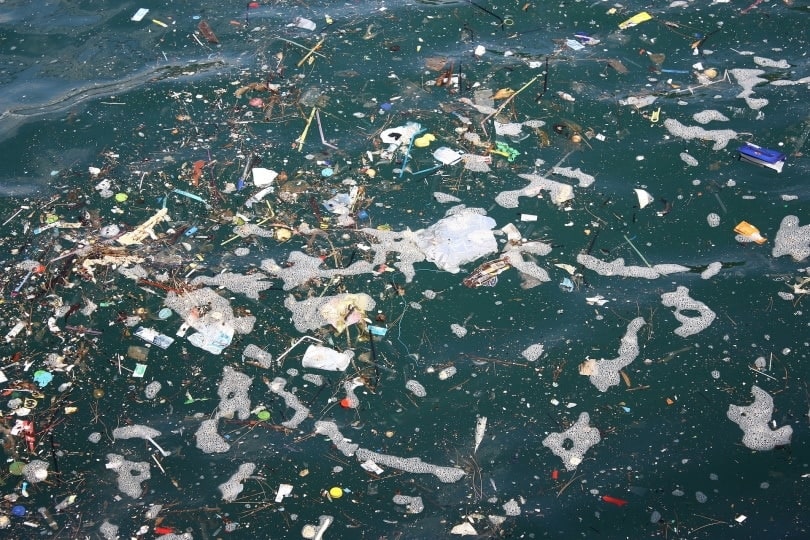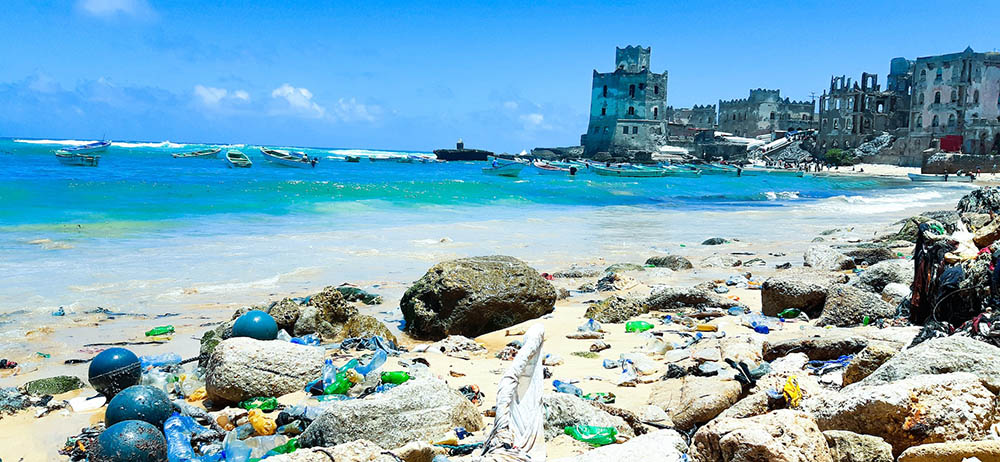Note: This article’s statistics come from third-party sources and do not represent the opinions of this website.
All life owes its existence to the oceans from which scientists theorize it originated. About 10% of the global population depends upon these waters for food. Nearly 40% of Americans live in coastal areas. Therefore, it only makes sense that we make managing ocean pollution a priority. However, it can sometimes be difficult to conceptualize the issues’ gravity. Our stats will help put it in perspective.
If you don’t live near the coast, you may not realize the enormity of the world’s oceans. After all, they make up 71% of the Earth’s surface. That means problems in these waters exist at a global level, requiring equally comprehensive solutions and international cooperation.
Keep reading as we discuss different ocean pollution statistics:

15 Ocean Pollution Statistics
- The Great Pacific Garbage Patch (GPGP) is more than 617,763 square miles.
- It can take as long as 15 years for a cigarette butt to decompose in the ocean.
- Annually, about 1 in 3,750 of the 120 billion straws Americans use end up in the world’s oceans.
- The plastic waste of the United States makes up only one-half of 1% of the total in the world’s oceans.
- Lawns are the most irrigated crop in the United States.
- Americans improperly dispose of about 200 million gallons of discarded oil each year.
- The discarded oil from one oil change can contaminate 1 million gallons of water.
- Land is the biggest polluter of oceans, contributing about 80% of the contaminants.
- Harmful algal blooms cost Washington $40 million of losses in tourism from recreational razor clam harvest.
- About 3 billion people around the world are without access to proper sanitation facilities.
- About one-third of shellfish habitat is negatively impacted by pollution.
- A plastic-eating enzyme called PETase holds promise for plastic removal by making a visible dent in as little as 96 hours.
- About 85% of the vanillin flavoring production is currently sourced from chemicals originating from fossil fuels.
- Over half of Americans will choose sustainable seafood to protect the environment, even if it costs more.
- Recycling just one ton of used oil filters can reclaim 60 gallons.


The Extent of Ocean Pollution
1. The Great Pacific Garbage Patch (GPGP) is more than 617,763 square miles. (Nature)
We all know that ocean pollution is a problem. The Great Pacific Garbage Patch (GPGP) is a sign of how big it is. This massive, floating area of trash is a sprawling 617,763 miles blanketing a site between Hawaii and California. About 46% are discarded fishing nets.

2. It can take as long as 15 years for a cigarette butt to decompose in the ocean. (Belgium Federal Public Service)
Waste takes time for bacteria and other factors to decompose various materials. The problem is that it can take a long time for it to happen. It may surprise you to learn that a discarded cigarette butt will persist in the environment for up to 15 years. Chewing gum lasts even longer at 25 years or more. That’s something to think about when deciding where to get rid of it when you’re done.
3. Annually, about 1 in 3,750 of the 120 billion straws Americans use end up in the world’s oceans. (Phys.org)
It’s helpful to put the figures in perspective to understand the gravity of ocean pollution. Many people point to plastic straws as a primary culprit. Unfortunately, bans are more of a feel-good gesture than a solution. The fact is they make up only about 2% of the estimated 9 million tons of trash.
4. The plastic waste of the United States makes up only one-half of 1% of the total in the world’s oceans. (Science.org)
It’s a common assumption that just because the United States is an industrialized country that it is a major polluter. While it’s true on some scores, it doesn’t apply to plastic and other types of waste ending up in the oceans. The reason is that we are much better at managing our municipal waste than other nations that pollute the water more than us.

5. Lawns are the most irrigated crop in the United States. (Environmental Management)
That well-maintained lawn comes at a price. American lawns are the most irrigated crop in the country. The problem with watering our yards is that anything we put on the grass can potentially end up in the ocean. We’re talking about fertilizers, pesticides, and other chemicals that can harm marine life.
6. Americans improperly dispose of about 200 million gallons of discarded oil each year. (MO DNR, US EPA)
People often point to oil spills as a significant contributor to ocean pollution. The fact is that improper disposal of used oil is the real culprit, with about 200 million gallons discarded annually. That figure is startling on its own. However, when taken with our next stat, it’s easy to understand why it’s a serious problem. It’s worth noting the Exxon Valdez spill amounted to 62 million gallons.
7. A single pint of discarded oil can contaminate 1 acre of water. (US EPA)
Oil is lighter than water, which explains why it creates the visible slicks you see on the surface. Several factors affect how it will spread, including the water’s temperature and the viscosity of the contaminant. It’s more likely to affect a greater area if the temps are warm. Likewise, if it’s viscous, it may sink and further impact aquatic life. Just one quart can affect 1 million gallons of water.
8. Land is the biggest polluter of oceans, contributing about 80% of the contaminants. (NOAA)
About 80% of the contaminants entering the oceans come from the land. However, it’s not just plastic water bottles or aluminum cans fouling the water. Much of it comes from nonpoint source pollution (NSP). It includes the toxins washing off our roads and driveways that eventually make it to waterways and, finally, the ocean.

The Effects of Ocean Pollution
9. Harmful algal blooms cost Washington $40 million of losses in tourism from recreational razor clam harvest. (NOAA)
One of the more devastating impacts of ocean pollution is the development of harmful algal blooms (HABs). They occur when runoff supplies a boost in nutrients that causes a spike in algae. Unchecked, the organisms create toxic aquatic environments when they die and foul the water. Washington found out the hard way what the effects were on tourism and the loss of revenue.
10. About 3 billion people around the world are without access to proper sanitation facilities. (WRI)
Managing ocean pollution can have benefits for other members of society. For example, improving wastewater management can help the 3 million people who lack access to clean water. Fulfilling their needs can improve the water quality in the oceans.
11. About one-third of shellfish habitat is negatively impacted by pollution. (NOAA)
The effects of ocean pollution on marine life vary depending on their role in the ecosystem. Filter feeders like shellfish often suffer from the impacts sooner than other organisms. Microplastics and heavy metals can harm wildlife. An estimated one-third of shellfish habitat is contaminated by these materials.

The Future of Ocean Pollution
12. A mutated form of the plastic-eating enzyme PETase holds promise for plastic removal by making a visible dent in as little as 96 hours. (NREL)
Scientists figured out early on that the plastic-eating enzyme PETase served a valuable environmental function near a Japanese bottle-recycling facility. An accidental mutation resulted in a super enzyme that could work faster and more efficiently than the naturally occurring one. While more research is needed, hope exists that technology may offer a solution to our ocean-borne plastic problem.
13. About 85% of the vanillin flavoring production is currently sourced from chemicals originating from fossil fuels. (Live Science)
Sometimes, perplexing problems require creative solutions. Perhaps none is more innovative than one fix for our plastic waste problem with vanillin. Scientists developed a method for converting these materials into this popular flavoring. An estimated 85% is sourced from fossil fuels from upcycled plastic.
14. Over half of Americans will choose sustainable seafood to protect the environment, even if it costs more. (Seafood Watch)
Thanks to the efforts of organizations like the Monterey Bay Aquarium, consumers are more informed about their choices, even when it comes to the food they eat. The Seafood Watch program began as an exhibition before taking off to become a leader in sustainability. Today, individuals have a better understanding of the impact of their purchases and their buying power.

15. Recycling just one ton of used oil filters can reclaim 60 gallons. (US EPA)
Recycling offers a significant benefit for manufacturing. Recovering one ton of used oil filters can recoup 60 gallons and supply 1,700 pounds of steel. That can, in turn, reduce the environmental impact of producing these materials from scratch. Consumers benefit from lower costs.

Frequently Asked Questions About Ocean Pollution
Are plastic bans effective?
As we’ve discussed, bans don’t make a significant dent in ocean pollution. However, if you want to use reusable items, by all means, do so. However, your energy is better directed toward actions that can make a difference, such as recycling and proper disposal of any hazardous materials.
(Phys.org)
Can’t we just clean up the ocean?
Sadly, it’s not that easy. The garbage patches don’t make it easy since they’re constantly in motion and moving up and down the water column. It won’t be practical or environmentally sound to try and filter out the debris. Remember that the microplastics are minuscule in size. A risk exists of removing foodstuffs like plankton for filter feeders.
(NOAA)

What’s the best solution for ocean pollution?
NOAA recommends focusing our efforts on prevention with measures like recycling. Another way you can help is by participating in shoreline clean-up programs. The waste you remove won’t end up contributing to garbage entering our oceans.
(NOAA)
What is the biggest threat to our oceans?
Any Internet search on ocean pollution will likely focus on plastic waste. While it is a factor, the greater threats to marine life are overfishing and climate change. The former can decimate entire populations of species that may not recover. That makes choosing sustainable seafood vital. Of course, the latter is a global issue. However, anything you can do to reduce your carbon footprint will help.

Conclusion
Ocean pollution is one of the greatest environmental dangers of our lifetime. Cleaning these waters will require cooperation and a global effort to prevent the problems from growing larger and out of our control. Take heart from the fact that we’re making strides in our municipal waste management, recycling, and sustainability. Always consider the impact of your choices to protect our planet.
Featured Image Credit: Abukar Sky, Unsplash
